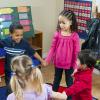- Reflect on what it means to be a responsive preschool teacher
- Identify how to support resiliency in preschoolers.
- Brainstorm how to cultivate and nurture social-emotional competence in your preschool classroom and program.
Learn
Know
How do you nurture and sustain your social-emotional health in your personal life? Are there rituals or activities you engage in that make you feel more connected to yourself or to others? Are there individuals who nurture and inspire you to be and feel your best?
Now consider your professional life. How do you foster your social-emotional health at work? What elements of your work environment sustain your social-emotional health? Is it relationships with coworkers, supervisors, children, and families? Is it the freedom to work independently to plan experiences and use materials? Is it guidance and constructive feedback from colleagues or sharing concerns and ideas and brainstorming solutions when situations arise?
Throughout this course, you have been learning about the importance of being a responsive caregiver for children’s social-emotional development and that caring, responsive, and attentive adults can foster children’s social-emotional competence and growth. In order to be a responsive caregiver, you must think about your own social-emotional health as it often affects your relationship with others.
What Does It Mean To Be A Responsive Preschool Teacher?
Responsive caregivers use every opportunity to ‘get in tune’ with the children in their care. Responsiveness is demonstrated when an adult provides support, responds immediately, and reacts with positive affect that matches the child’s needs and development. Researchers Carl Dunst and Danielle Kassow (2008) have identified key characteristics of sensitivity and responsiveness in caregiver-child relationships. Although their research focused on defining sensitive caregiving for infants or toddlers, below we outline the responsive characteristics that are most important for preschool teachers. In the Explore section of this lesson, you will have an opportunity to reflect on these elements as they relate to your own experiences in preschool.
Dunst and Kassow’s 6 Characteristics of Responsiveness
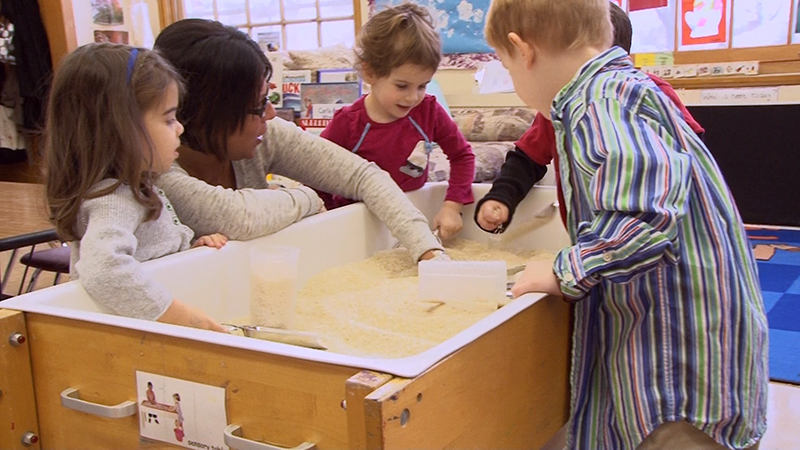
Positive attitude:
The teacher frequently smiles, laughs, and provides positive statements to children. For example, a teacher may smile at children as they arrive in the morning and say, “I am so happy to see you this morning!” or the teacher may smile and laugh in response to a child telling a joke. Research suggests that teachers should provide five positive statements for every directive or negative statement. Negative or directive statements include demands (e.g., “Stop running on the playground”), nags (e.g., “I keep telling you to stop dripping water on the floor”), criticism (“You are not listening or doing what you are supposed to do”), or avoidance of a particular child (e.g., the teacher may see a child struggling with an activity and avoid the opportunity to help). Teachers should avoid and limit negative and directive statements. Positive statements can be verbal or nonverbal. Nonverbal positive statements can include following the child’s lead in play, hugs, smiles, specific praise and encouragement, listening to a child tell a story or talk about an experience, or giving positive comments to a child’s mom and dad upon arrival or departure.
Support:
The teacher is available and helps each child develop. For example, many preschool children are learning to share toys and take turns with peers. The teacher arranges multiple opportunities each day for children to practice taking turns during different classroom activities, such as circle, center and snack time, or outdoor play. The teacher supports children in taking turns and sharing by modeling turn taking, physically supporting children, and providing encouragement and specific praise for sharing and taking turns.
Response quality:
The teacher responds immediately and appropriately to match the child’s needs. For example, if a child in the classroom fell and is crying because of a scratch, the teacher calmly talks to the child until he or she is calmed down and helps the child bandage the affected area. If the child is excited because he or she has just mastered a new skill (such as riding a tricycle), the teacher responds with excitement as well.
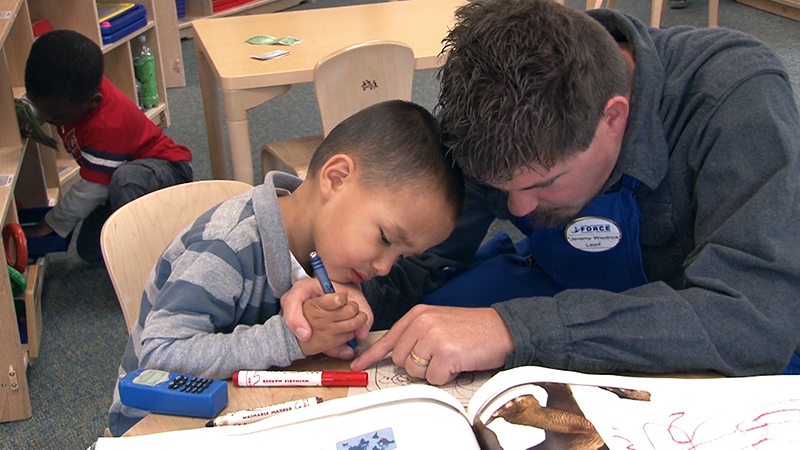
Synchrony:
The relationship between the teacher and child is reciprocal and rewarding for both parties. For example, the teacher and the child laugh together as they read a favorite silly book, or they enjoy taking turns singing silly songs while washing hands before snack time.
Stimulation:
The teacher arranges the environment to provide multiple opportunities for play and learning, as well as the engagement and encouragement of children. The teacher includes a range of developmentally appropriate materials in the classroom, intentionally uses opportunities to teach children to take turns engaging and playing with the materials, and monitors children to ensure they are engaged and learning from their environment. Additionally, the teacher acknowledges individual differences, preferences, and learning styles in children and is responsive to their needs.
Mutuality:
The adult and child frequently share attention to objects, events, and people in the environment and discuss them. For example, while playing on the playground, the teacher and child both observe a bird flying over their heads, or during snack time, a teacher and children may look and talk about a new poster on the wall.
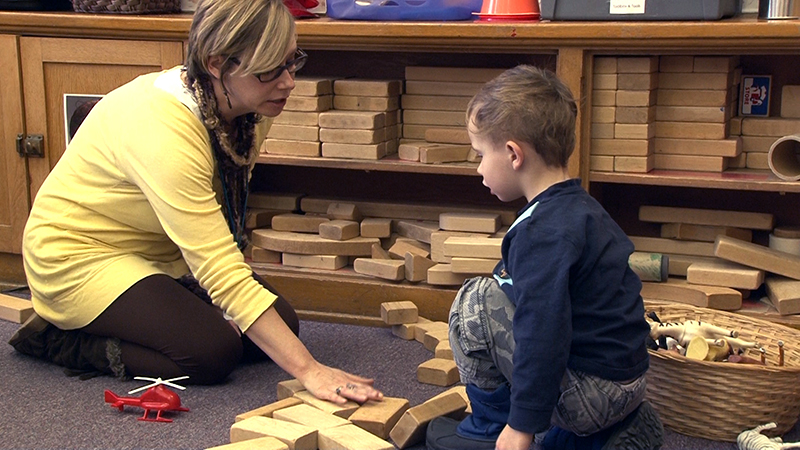
Responsive caregiving results in a relationship that is stable, enduring, and secure. It is within the security of this relationship that a child feels safe, confident, and able to explore the world with curiosity. Everyday stressors exist in childhood including deployment, depression, death of a family member, natural disasters, or poverty. While the ideal situation is removal of all stress, we know that scenario is impossible. However, children who develop resilience gain the ability to better cope with change and adversity. The strengths of the family, the environments in which the preschooler spends time, and the child himself or herself can enhance resilience. These strengths are also referred to as protective factors and are closely linked to social-emotional well-being. Social-emotional well-being is the ability to form healthy relationships, regulate strong emotions, and explore the environment and learn. When their parents or other caregivers support children, they believe in themselves and realize that they are capable. When adults encourage children to participate in the family or classroom by giving them responsibilities and offering them choices about their environment, young children feel a sense of belonging and competence. Protective factors, and therefore, social-emotional development, are strengthened when nurturing adults remain responsive in all interactions and experiences.
The illustration below helps to explain the cyclical nature of how protective factors encourage resilience.
American Academy of Pediatrics. (n.d.) Promoting resilience. https://www.aap.org/en-us/advocacy-and-policy/aap-health-initiatives/resilience/Pages/Promoting-Resilience.aspx
Practices to Support Preschooler’s Social-Emotional Development
Young children develop and learn within the context of relationships. Preschoolers develop positive social and emotional skills such as how to join play, form friendships, communicate emotions, and deal with life’s challenges as a result of the close relationships they have with family members and teachers. The section below details specific practices that teachers can engage in to support preschoolers social and emotional development.
Responsive Communication
- Talks frequently with children and responds to their communication
- Comments on children’s interests, activities, or actions
- Engages in back-and-forth interactions
- Expands on children’s vocalizations by adding descriptive words and asking questions
- Provides positive descriptive feedback
Responsive Interactions
- Fosters healthy relationships between themselves, children, and their families
- Uses a positive and supportive tone
- Positions self at children’s level during interactions
- Makes eye contact and smiles to connect with children
- Shows physical affection
- Demonstrates interest and provides positive attention
Responding to Distress and Challenging Behaviors
- Remains calm and supportive when a child experiences distress
- Uses redirection in response to a preschooler’s challenging behavior
- Provides tools for preschoolers to use to calm down
- Helps preschoolers that are angry or upset to identify and solve the problem
- Provides opportunities for children to practice self-regulation skills
Supporting Social Interactions
- Remains available and in close proximity during interactions with peers
- Encourages children to initiate and respond during interactions with others
- Models social skills (greetings, turn-taking, problem solving)
- Provides explanations to help children understand other’s intentions
- Comforts children when negative interactions occur
- Gives positive feedback when children engage in prosocial behaviors
- Provides opportunities for preschoolers to work cooperatively with others
Encouraging Engagement
- Establishes predictable routines and activities
- Engages children with materials and activities that are developmentally appropriate
- Designs activities to support children’s emotional literacy
- Models language and interaction with materials
- Provides opportunities for preschoolers to make choices during activities, routines and transitions
- Uses additional supports (visual schedule, timer) as needed to support transitions
- Communicate what is happening before and during a routine or activity
- Models expectations during routines and activities
Teaching Emotions
- Uses emotion words and reinforce children’s use of emotion words
- Labels feelings and expresses empathy
- Matches affect to children’s affect during interactions
- Models self-regulations strategies
- Helps preschoolers solve problems
- Include pictures with emotion labels to teach about emotions
- Read books, sing songs, and play games about emotions
Source: National Center for Pyramid Model Innovations (2020). Caregiver practices to support infant-toddler social emotional development. https://challengingbehavior.cbcs.usf.edu/docs/Caregiver_Practices.pdf
What does it mean to be a Socially and Emotionally Competent Preschool Teacher?
Social-emotional growth and development is a crucial part of the human experience; it helps us learn things about ourselves, establish and maintain relationships with others, and allows for meaningful learning experiences. In your daily interactions with preschool-age children, it is your responsibility to build relationships with them and foster relationships among children by designing supportive environments and by being responsive to their ideas and interests. Building relationships is an essential, primary component of good teaching.
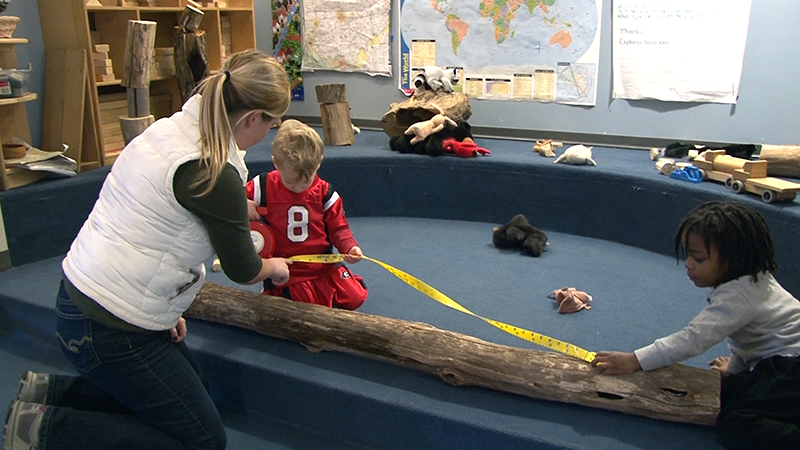
In Lesson One, you had the opportunity to explore your own views on social-emotional development. This lesson extends this exploration by encouraging you to consider social-emotional development in your workplace and ask yourself what it means to be a socially and emotionally competent preschool teacher.
In your work, you are responsible for creating meaningful experiences that incorporate opportunities for the practice of social-emotional skills throughout the day. Being a socially and emotionally competent teacher can be expressed in a number of different ways. Below are some strategies to consider:
- Take the time to work on establishing and maintaining relationships with children and colleagues in your care setting and program
- Try to work out and problem solve solutions to challenges or problems that arise
- Demonstrate flexibility
- Allow yourself to make mistakes
- Be nurturing and responsive
- Try new things out
- Ask for help or support when facing difficulties
- Lend a helping hand to others in need
- Be willing to accept new or different perspectives
- Recognize diversity
- Be open-minded
- Share your own emotions and thoughts
What are some of your own views about being a socially-emotionally competent preschool teacher? Pause for a few moments to think about this.
See
Though preschoolers need responsive relationships to foster their social-emotional learning, you benefit your entire classroom community when you demonstrate responsiveness with everyone. Listen and watch this video to learn about the importance of having responsive relationships with children, families, and coworkers.
Responsive Teaching
Do
Cultivating and Nurturing Social-Emotional Competence in your Preschool Classroom and Program
Social-emotional competence helps you become part of a workplace community that feels welcoming, supportive, friendly, energetic, and nurturing. It helps you engage children, families, and colleagues in a range of meaningful ways. Consider the following when engaging with children, families, and colleagues in your program.
Engaging with children
- Demonstrate empathy and compassion when working with children. Inspire children to be empathetic and compassionate by demonstrating these attributes yourself.
- Demonstrate positive social skills with children throughout the day, encourage children to do the same, and positively reinforce them when doing so.
- Use children’s backgrounds, experiences, and interests as inspiration for ideas about experiences and activities in your classroom.
- Cultivate a climate of respect and appreciation of individual differences in your classroom. Invite children to share their views and experiences with you.
- Demonstrate respect for children’s values and opinions. Your example will be setting the tone for how children view themselves and for how they treat others.
Engaging with families
- Invite families to share meaningful experiences.
- Provide opportunities for families of the children in your classroom and program to meet and get to know each other.
- Invite families to observe and participate in some of your classroom activities.
- Send home books with the children about emotions and social-emotional skills.
- Encourage families to nurture social-emotional skills at home by extending some of your classroom and school experiences in the home environment.
Engaging with colleagues
- Connect with your colleagues. Share your interests and experiences with colleagues during staff meetings, lunch breaks, or in-service days. Explain how these interests drive some of the experiences you create for children in your classroom. Get to know the people you work with on a personal level.
- Exchange ideas with colleagues about experiences that foster social-emotional growth. Invite a colleague to come to your room, observe your activities, and give you feedback. Offer to do the same for your colleagues.
- Ask a trainer, coach, or administrator to observe your classroom so they can offer feedback about your use of materials and experiences to promote children’s social-emotional growth.
- Acknowledge colleagues who are doing great things, who offer you guidance and constructive feedback, and who inspire you to strive for excellence and to be a team player.
Explore
How do you define resilience and social-emotional development? Use the Thinking About My Own Resilience activity to reflect on your own resiliency and how your relationships influence your social behavior. Complete the activity and discuss your responses with a trainer, coach or administrator.
How do responsive teacher characteristics relate to you and your practice with children?
Use the Characteristics of Responsive Teachers checklist and the Responsive Teacher Checklist Self-Reflection to examine your own responsiveness as a preschool teacher. . Take a few minutes to read and respond to the questions in each of these handouts. Then, share and discuss your responses with a trainer, coach, or administrator.
Apply
Review the links included in the Learning More About Resilience handout to further explore and better understand adult resilience and social-emotional well-being: After accessing and reviewing some of the video clips and information, share and discuss your experience with a trainer, coach, or administrator.
Glossary
Demonstrate
American Academy of Pediatrics. (n.d.) Promoting resilience. https://www.aap.org/en-us/advocacy-and-policy/aap-health-initiatives/resilience/Pages/Promoting-Resilience.aspx
Berk, L. E. (2013). Child development (9th ed.). Pearson.
Carter, M., Cividances, W., Curtis, D., & Lebo, D. (2010). Becoming a reflective teacher. Teaching Young Children, 3(4), 18-20.
Colker, L. J. (2010). Teaching preschoolers to think optimistically. Teaching Young Children, 4(1), 20-23.
Dunst, C., & Kassow, D. (2008). Caregiver sensitivity, contingent social responsiveness, and secure infant attachment. Journal of Early and Intensive Behavior Intervention 5, 40-56. http://files.eric.ed.gov/fulltext/EJ805609.pdf
Early Childhood Learning & Knowledge Center. (2020). Responsive caregiving as an effective practice to support children’s social and emotional development. https://headstart.gov/video/responsive-caregiving-effective-practice-support-childrens-social-emotional-development
Erdman, S., Colker, L.J., & Winter, E.C. (2020). Trauma and young children: Teaching strategies to support and empower. National Association for the Education of Young Children.
Mulrooney, K. & Williams, D. (2012). Understanding the experiences of young children in military families in the context of deployment, reintegration, injury, or loss. https://www.zerotothree.org/resources/33-research-and-resilience
Pizzolongo, P.J. and Hunter, A. (2011). I am safe and secure: Promoting resilience in young children. Young Children, 66(2), 67-69.
Joseph, G. E., & Strain, P. S. (2004). Building positive relationships with young children. Young Exceptional Children 7, 21-29.
Joseph, G. E. & Strain, P. S. (2003). You’ve got to have friends. Center on the Social and Emotional Foundations for Early Learning: Training Materials.
Trawick-Smith, J. W. (2013). Early childhood development: A multicultural perspective (6th ed.). Pearson.


